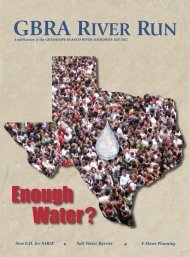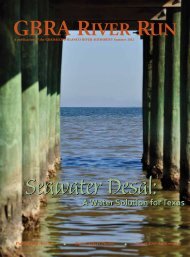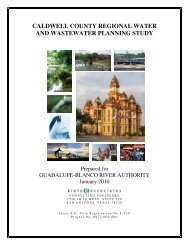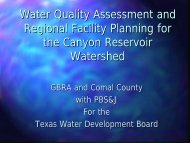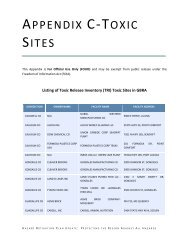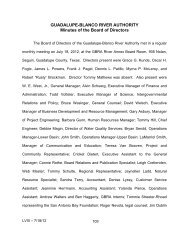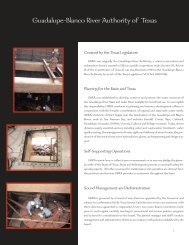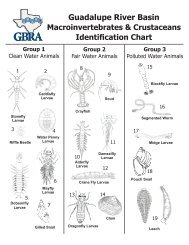Summer 2009 - Guadalupe-Blanco River Authority
Summer 2009 - Guadalupe-Blanco River Authority
Summer 2009 - Guadalupe-Blanco River Authority
- No tags were found...
Create successful ePaper yourself
Turn your PDF publications into a flip-book with our unique Google optimized e-Paper software.
y Joel Williamsune normally is the second-rainiest month in the <strong>Guadalupe</strong><strong>River</strong> Basin, but by the end of June <strong>2009</strong>, the countryside waswilting and rivers and lakes were shrinking under the relentlesssunny days.As this brutal drought continued, South Central Texas looked like itcould catch on fire any minute. Burn bans were in effect and fireworksfell under severe restrictions for the July 4th holiday in some parts ofthe region with the dubious distinction of being included among theworst of the current droughts in the United States.September 2007 through June <strong>2009</strong> turned out to be the driest22-month period on record, with less than 24 inches of rainfallrecorded at San Antonio, about one-third of the historical norm.Canyon Reservoir continued to drop to its lowest levels everrecorded since 1968, when the then-new lake formed by theconstruction of Canyon Dam on the <strong>Guadalupe</strong> <strong>River</strong> first reachedconservation pool level. Every day without rain, the lake managed bythe <strong>Guadalupe</strong>-<strong>Blanco</strong> <strong>River</strong> <strong>Authority</strong> (GBRA) reached a newrecord low.Flow on the river at Spring Branch, just above Canyon Reservoir, hadslowed to less than 4 cubic feet per second (cfs) by the beginning ofJuly, or less than one-seventieth of the normal flow going intothe reservoir.The reservoir briefly experienced an increased drop fromJune 30 to July 5 when the GBRA raised the release rate atCanyon Reservoir from 60 cfs to 125 cfs to fulfill downstreamcommitments. Those commitments included providing adequatewater for the City of Victoria, which was required to stop pumping fromthe shrinking <strong>Guadalupe</strong> until it received some of its allotment fromCanyon Reservoir.The release also proved to be a welcome development forrecreational users just downstream from the reservoir, such as rivertubers and the businesses that serve them.“Canyon is fulfilling its role of storing flood waters and releasingthem to provide beneficial uses to cities, industry and others,” GBRAGeneral Manager Bill West said.“Overall, I think people here are doing a really good job conservingwater and doing their part,” Scheel said. “With one or two exceptions,I am very pleased that people have a good awareness of how they cando their part.”Roland Ruiz, a spokesman for the Edwards Aquifer <strong>Authority</strong>, saidthe public’s awareness of the need to conserve is high.“It seems that generally awareness is higher than it’s ever been,”Ruiz said. “The folks across the region are aware that the resource, theaquifer, is not something to be dismissed.”During the drought of record, which lasted from 1947 to 1957,Comal Springs in New Braunfels stopped flowing for 144 days in 1956.On Aug. 17, 1956, the Edwards Aquifer dropped to its lowest recordedlevel, 612.5 feet, mean sea level (msl).Although the region’s water conservation practices are amongthe nation’s best, the population putting demands on the aquifer hassteadily increased. More than 2 million people depend on the Edwardstoday as a primary source of drinking water, and for other domestic,agricultural, industrial, and recreational uses. That translated to anestimated 35 billion more gallons pumped from the aquifer in 2008than the amount pumped in 1956.Comal County Judge Danny Scheel said his area’s recreational waterindustries still were doing well, but that residents were having to dosome things differently. That includes the inability to water grasswhen they wanted, and the need for some area ranchers to haul water.One Comal County developer was voluntarily delaying the filling of animportant “<strong>River</strong> Walk” feature, he said. However, Scheel said he didhave a talk with another developer who was pumping large amounts ofwater into a decorative pond, who stopped the pumping soon afterthat conversation.In July, Canyon Reservoir had fallen to 895 msl, a full 14 feet below its normal 909 msl.13Photo by LaMarriol Smith




